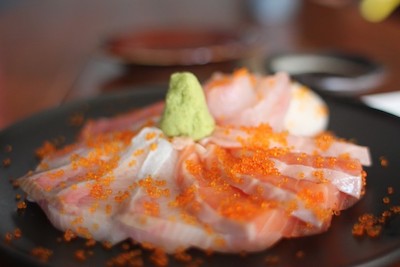We are reader supported. When you purchase through links on our site, we may earn an affiliate commission. Also, as an Amazon affiliate, we earn from qualifying purchases.
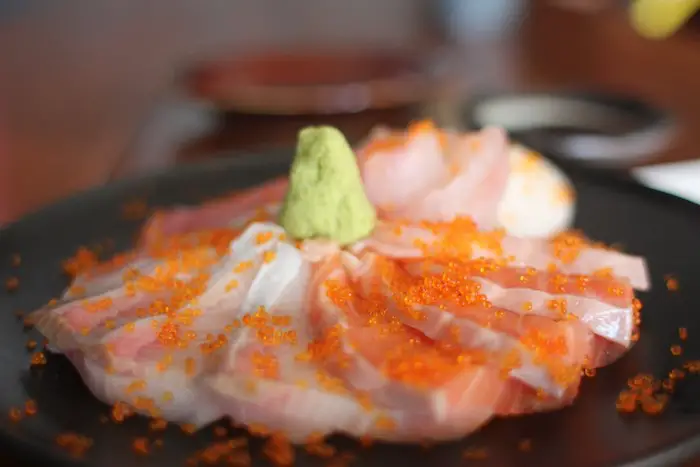
I was slightly apprehensive about eating raw food until I developed a taste for sushi several years ago. However, the real surprise was not how good taste raw tuna or salmon tasted, but the delightful flavor and texture of fish roe (eggs), known as Tobiko in Japanese.
Until then, I was unaware (many people still don’t know) about these crunchy and savory fish eggs that are commonly used in Japanese cuisine. While I thought raw meat, cucumber, and avocado were the main fillings used in sushi, I was introduced to tobiko by a friend in a sushi restaurant.
We ordered a dragon sushi roll that had eel, avocado, cucumber, and tobiko. As I took a bite, loved the way those crunchy little balls popped inside the mouth leaving a savory flavor. Since then tobiko became one of my favorite side fillings/ toppings in a sushi roll.
Knowing that there are many people out there who are unfortunately unsure about eating tobiko, I wish to share my knowledge about this rich and delicious Japanese delicacy.
Contents
Getting To Know Tobiko (Flying Fish Roe)
If you are in a situation where I was some ten years ago, you need to first understand what is tobiko. While there are different varieties of fish roes such as ikura, masago, uni, mentaiko, kazunoko, and ebiko, tobiko and masago are the most common type.
People often get confused between masago and tobiko, however, there are some notable differences that I will discuss later in the article. Tobiko is the Japanese word for eggs or roe of flying fish that are typically found in the tropical waters.
The flying fish eggs are small in size, ranging between 0.5 and 0.8 mm. In the natural habitat, tobiko is larger than masago (smelt roe) but smaller than ikura (salmon eggs). They originally have a vibrant red-orange color and look extremely bright.
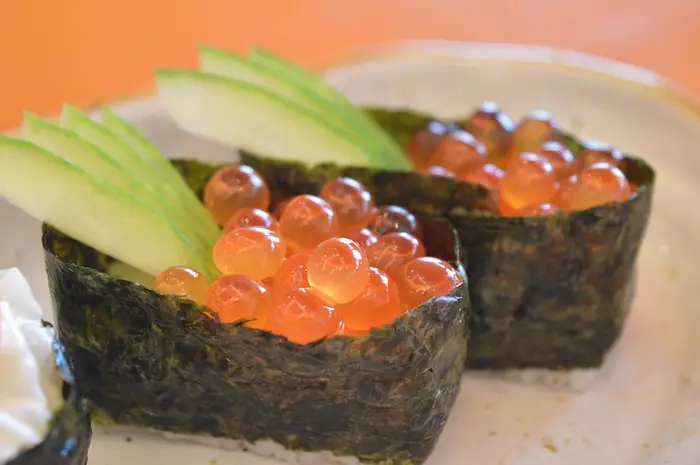
If you see black or green tobiko on your sushi roll, don’t be alarmed. It does not mean that fish roe has gone bad. The change in color and flavor can be easily brought about by adding dyes such as squid ink for black color; yuzu juice for yellow color; beet for red color, and wasabi for green color.
The color creations can be used to decorate different types of inside-out sushi rolls, nigiri, or gunkan maki. The color eggs also look great in a charishi bowl.
Flying Fish That Are Sources Of Tobiko
Tobiko comes from Flying Fish that belong to the Exocoetidae family. These species of fish are known for their ability to fly out of the water using their tails and fins to escape the large predators. The flying fish usually feed on plankton and often become prey to porpoises, squid, and other larger fish.
Flying fish can wiggle their tails nearly 70 times per second and they can fly up to a quarter-mile above water at the rate of over 40 mph. These fish usually avoid the open ocean waters, and they can be found closer to the shorelines of islands and bays.
Flying fish are found in both temperate and tropical waters around the world. Even though they are often captured wild, the raw fish eggs are often sent to Japan, Taiwan, and Iceland for processing. The eggs are primarily collected by fishermen in the springtime, near the coast of Taiwan.
After catching the fish roe, they typically undergo processing with flavorings, spices, and added colors to form different varieties of tobiko. The finished products are quickly frozen to retain their freshness. The colored fish eggs usually have a salty and smoky flavor, with an amazing crunchy texture.
In the northern Taiwan Strait, situated to the south of East China Sea, flying fish roe is usually harvested by studying the behavior of female flying fish. They usually seek floating objects such as rafts of seaweed to lay their eggs. When a good amount of fish roe is accumulated, the fishermen collect the roe before the male fish can fertilize them.
Another method is when the fishermen catch pregnant flying fish and remove the eggs. After taking out of the casings, the eggs are allowed to sit in salt water for several hours. To retain the original flavor of tobiko, chefs or fishermen often don’t do more than treating the roe with salt water. This method helps in removing excess moisture and concentrating the flavors.
The Experience Of Savouring A Tobiko Sushi
If you have had the opportunity to enjoy tobiko nigiri sushi, you would probably envision a clumped bed of rice topped with colorful eggs every time you hear tobiko sushi. However, the beauty of sushi is that the ingredients can be used in myriad ways.
If you prefer a sushi roll over nigiri, you will find several Japanese restaurants around the world serving tobiko sushi rolls. While most of the traditional styles include adding fish, vegetables, and roe rolled with a Nori sheet, there are some served as gunkanmaki or battleship sushi.
Each piece of tobiko when separated may appear golden in color. However, when they are combined together, they usually look red. You can see a rich and glossy shade if the fish roe is high-grade. In the case of poor quality, the color may not be so strong.
The addition of colors is usually done to enhance the taste of fish roe. Some restaurants may color the eggs to make-up for low quality. Despite the difference in color, almost all types of fish roe have a ‘popping sensation’ when chewed. Sushi fans around the world love this unique texture.
When consumed, tobiko usually leaves a dry aftertaste hence it is mostly paired with juicy meat or vegetables. They are also significantly low in terms of aroma. In some restaurants wasabi or soy sauce may be added on tobiko sushi, however, I feel that it tastes best without any condiments.
Difference Between Masago and Tobiko
If you are new into sushi making, you may often get confused between the appearance of masago and tobiko. Restaurants may also use dyed masago in the place of tobiko, which further makes things complicated to understand. Here are some key differences that will help you identify the real flying fish roe.

Masago is the dull eggs of Capelin fish and they are smaller in appearance than tobiko, the eggs of flying fish. Tobiko is not only larger and brighter, but also more flavourful. Most people like the salty-sweet flavor and crunchy texture of tobiko. They may also be dyed in red, orange, black, and green color.
While the tobiko flavor is more distinct and intense when compared to masago, it is not overwhelming. As a result, both these types of fish roes are used interchangeably. If you are a fish lover, you will appreciate the taste of tobiko on gunkan maki more than any other type of fish eggs.
People who love sushi but are not a fan of the fishy smell will prefer masago over tobiko due to the less intense taste and flavor. Masago is also much cheaper in price, so many restaurants prefer to use it as a substitute even though the menu says flying fish roe.
Ordering Tobiko Sushi First Time In A Restaurant
If you are new to eating tobiko, don’t try to order a lot in one go as you may find it overwhelming. Most people enjoy the texture and flavor of fish eggs while there are some who don’t really appreciate the sensation.
Those who are a fan of tobiko will not mind savoring the delicacy in any form or quantity. However, if you are a beginner, start with a small order to make sure you have someone who can share the sushi pieces with you.
Salmon Roe And Flying Fish Roe (Tobiko) Sushi
Ingredients:
- Cooked sushi rice
- Rice Vinegar
- Sugar
- Salt
- Tobiko
- Masago
- Parboiled octopus
- Parboiled squid
- Nori sheets
First, you need to cook sushi rice to perfection and then season it with vinegar, sugar, and salt. Find step-by-step instructions here.
To prepare fillings, take slices (medium thickness) of octopus and squid, cut them into thick strips and set aside
Put the bamboo mat on a plain surface and place the Nori sheet on it, rough side facing upwards.
Take a medium ball of seasoned sushi rice and layer it evenly on the Nori sheet, keeping half an inch gap on the sides
Arrange the squid and octopus strips horizontally to cover the length of the Nori sheet. Now, add a spoonful of tobiko and masago beside the line of squid and octopus.
Lift the bamboo mat from your end and start rolling, gently pressing in between to get a compact roll. Seal the edges with a little moisture.
Take a sharp Japanese knife and cut 6-8 pieces of the sushi roll. Serve with soy sauce and pickled ginger (see Amazon).
To make gunkan maki

In order to make gunkan maki, you need to take Nori strips thick enough to cover the rice bed and tobiko toppings on the top.

Take a golf ball size seasoned sushi rice and use your hands to shape it in an oval form. Now, take the Nori strip and wrap it around rice bed.
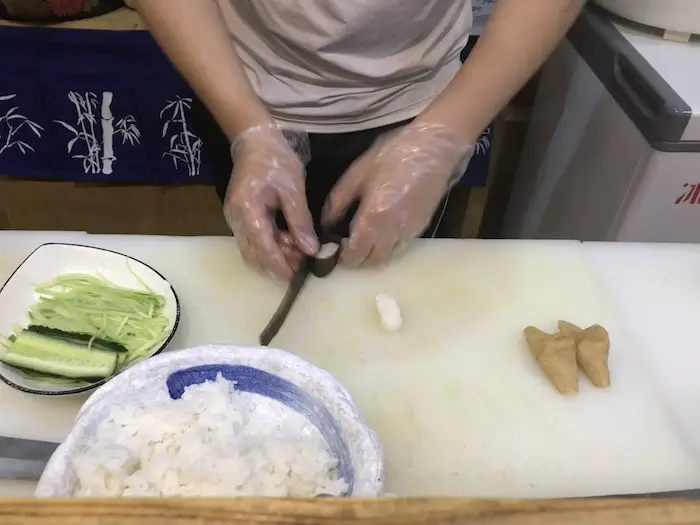
Take a tablespoon of tobiko and fill it over the top and garnish with finely minced sisho leaves. If you are feeling more creative, you may mix masago and Japanese mayo in a bowl and use the mixture as topping on gunkan maki.
Tuna, Salmon, and Avocado with Tobiko (Inside-Out Sushi Roll)
The combination of tuna, salmon, and avocado used in this recipe gives you a great looking and delectable sushi. You may use any part of tuna for the recipe but I feel the leaner Akami tastes best with salmon.
Ingredients
- Cooked sushi rice
- Vinegar
- Sat
- Sugar
- Sushi-grade salmon fillet
- Sushi-grade tuna steak
- Ripe but firm avocado
- Tobiko (flying fish roe)
Start cooking sushi rice at least 30 minutes before you plan to make the sushi rolls. When rice cools, season with vinegar, sugar, and salt following the instructions mentioned here.
Prepare tuna fish by cutting the steak into 1-cm thick strips. Repeat the same for salmon fillets. Cut the avocado into half around the seed, twist and remove seed, peel the skin and slice into 1cm wide slices.
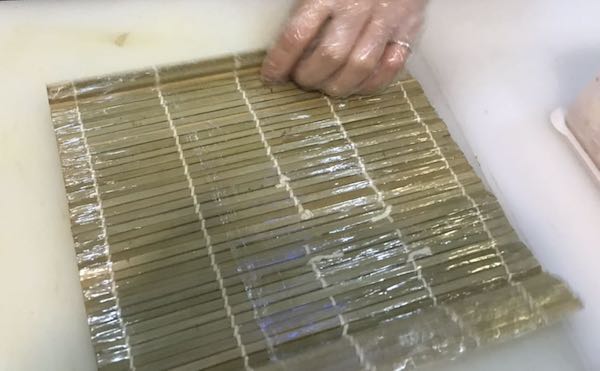
Keep the bamboo mat on the working surface and cover it with a plastic cling film. Now place the Nori sheet on it and layer with sushi rice generously. Remember to moisten your fingers so that rice does not stick.
Sprinkle 1 tablespoon of tobiko over the sushi rice generously and flip the Nori sheet to make it upside down
Arrange the tuna strips lengthwise towards you, put avocado slices beside it and follow with salmon strips. To enhance the flavor, you may add a little wasabi paste to the Nori before adding fillings
Lift the bamboo mat from the side closer to you and make a compact roll ensuring that there’s no gap between the Nori sheet and fillings
Moisten the knife blade and cut the roll into 6-8 pieces with the plastic wrap on. Serve with soy sauce, pickled ginger, and wasabi.
Related Question
Is Tobiko the same as caviar?
Caviar is the name given to fish eggs extracted from sturgeon and tobiko are fish eggs derived from flying fish. Ikura roe is the name used to refer to fish eggs derived from salmon fish.
Are fish eggs considered halal?
Fish eggs do not contain any blood and most theories say that they are naturally halal. However, there are some brands that market their products as halal eggs. This is purely a marketing strategy to lure a section of society.
Related Article: Is Sushi Halal Or Haram?
Is tobiko sushi safe for pregnant women?
Yes, fish eggs are absolutely safe to consume when you are pregnant or nursing as they are thoroughly pasteurized or cooked during processing.
How long do the fish eggs stay fresh?
The unopened jar of fish eggs can be kept fresh in the freezer for 10 days to two weeks. After opening the tin, let the eggs thaw completely before using them. Once thawed, the opened can be kept in the refrigerator for 2-3 days at the most.
What is the original flavor of tobiko?
In the natural state, tobiko does not have any flavor. It is only when the eggs are processed with seasoning and colors, they take up different flavors. Due to its crunchy and salty taste, tobiko is added to a variety of Japanese cuisine.
What types of sushi recipes can include tobiko?
You may use tobiko in different types of sushi to enhance the taste. It can be used as fillings in a traditional sushi roll and as toppings in an inside-out California style sushi. It also tastes great when added to gunkan maki or temaki recipes.
Where can you find tobiko?
You can find tobiko in any Asian grocery store near you. If you don’t have access to a grocery store, you may consider buying them online from Amazon.
See Also: What Is The Orange Sauce On Sushi

